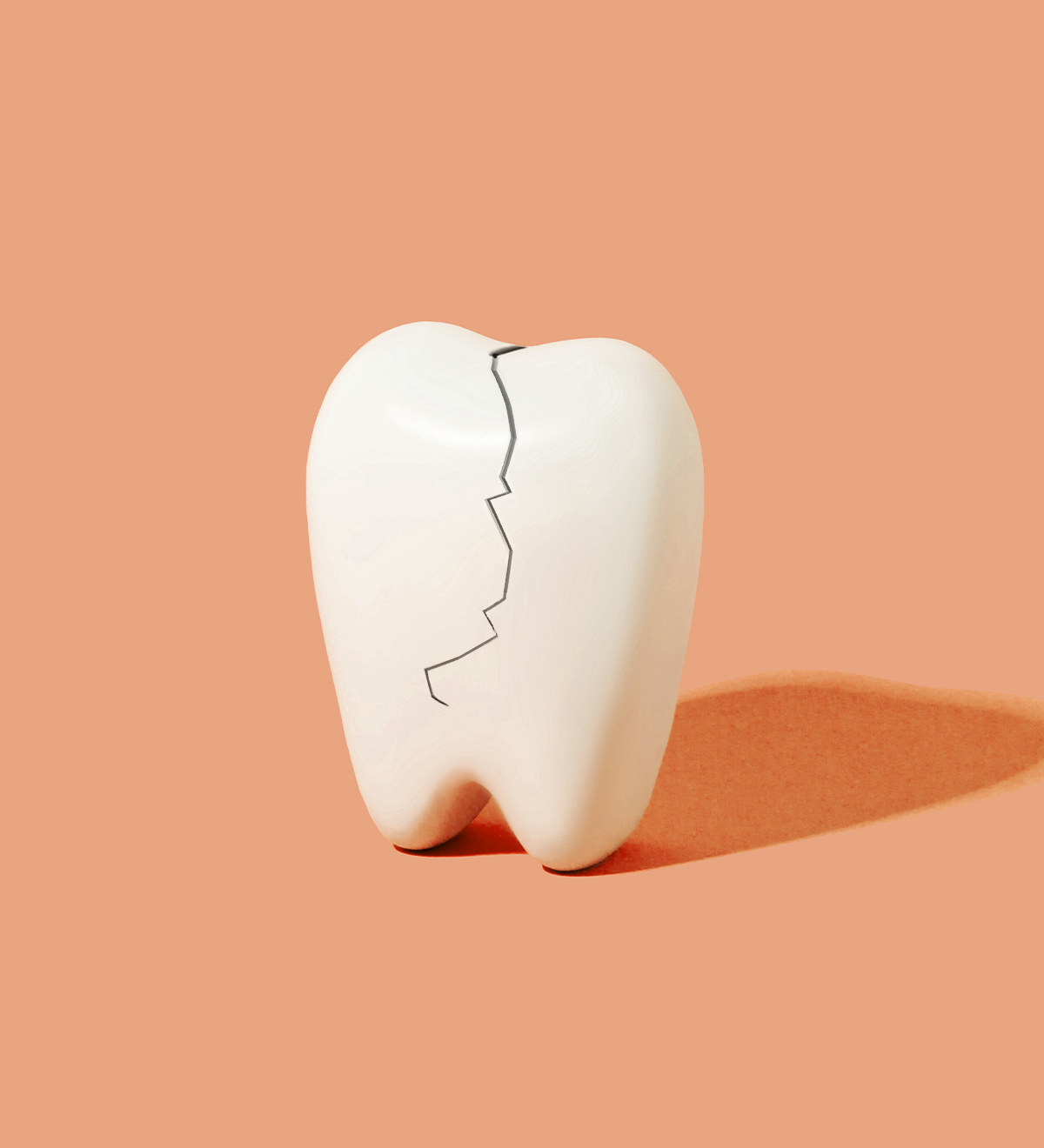I used to have good teeth. I was the only one in my family who didn’t need braces, and I didn’t have my first cavity until I was in my twenties. But all of that changed after my son was born. I suspect hormone and dietary changes during my pregnancy, both known to cause tooth decay and periodontal problems, as the likely culprits. In the decade since, I’ve spent at least $10,000 out of pocket on trips to the dentist.
The latest of my tooth dramas began in November 2017, when I went to the emergency room with a throbbing lump above one of my canine teeth. I was worried it was an abscess, but the dentist on call told me that my X-rays looked clear and recommended that I follow up with my regular dentist. By that point, I’d already burned through my $2,000 of dental coverage for the year (and now had to pay for the hospital visit out of pocket). I decided to tough it out with over-the-counter painkillers until January, when my insurance reset. I was in agony, but I knew that I couldn’t afford not to be.
When I finally did see my dentist, he took one look at the lump and referred me to an oral surgeon, who referred me to an endodontist, who confirmed that I’d been right all along: it was an abscess. She gave me prescriptions for antibiotics and super-strength Motrin and told me to come back in three days for a root canal, which I dutifully did. Even with private dental insurance, all of the appointments, scans, and procedures cost me hundreds of dollars. To pay for them, I used up what little money I had in the bank and gratefully accepted a loan from my mother to cover the rest. At least it was done, I told myself. I wouldn’t have to think about that damn tooth anymore.
But the pain never went away. There were more referrals, more pricey scans, and a new diagnosis: a vertical root fracture. The tooth would have to be pulled, and I would require an implant and a crown if I didn’t want a gap in my smile. I decided to put it off. Doing nothing was an easy choice since I was too broke to do anything else.
While I tried to figure out what to do next, other expenses came up: another $580 emergency root canal (mostly covered by insurance) and a $1,417 crown that I had to pay off in instalments. Then, at the end of last year, the filling on my bad tooth came out, leaving an ugly, aching hole. My dentist said he was pretty sure that the infection was now deep in the bone. The surgery and the implant needed to fix it would cost $3,666, plus another $1,500 for a crown. It was a few weeks before Christmas in the middle of a pandemic that had seen my income slow to a trickle—I didn’t have an extra $5,000 to spend.
After I turned to Twitter in a moment of panic, multiple people reached out to say that, if I did some kind of crowdfunding, they would make a donation. I felt a lot of shame and guilt about the idea—the former because, as a parent, I felt that I should have been financially solvent by now; the latter because I knew everyone else was feeling the pandemic pinch too. A few days later, with no other options, I created a GoFundMe for $3,500 that included the estimate sent to me by my periodontist. To my surprise, the cost was fully funded in less than an hour.
Many people would likely consider crowdfunding health care to be a uniquely American phenomenon, reflective of a notoriously broken system. Few think about it happening here, but a quick search through GoFundMe showed that I wasn’t the only Canadian who had turned to strangers on the internet in a final plea for help to cover their dental procedures. There were dozens of people like me, desperately in need of treatments that they couldn’t afford. While Canada’s health care system has long been a source of national pride, it was this experience, scrolling past photos of strangers’ gap-toothed smiles, that made me see just how flawed it is.
When the federal government set out to establish Canada’s health care system, just fifty-five years ago, the Royal Commission on Health Services—which was tasked with exploring what a publicly funded single-payer system might look like—undertook several studies on dentistry. While the commission did recognize the importance of oral health, it recommended against universal dental care, likely due to cost, personnel shortages, and the fact that many dentists were vehemently against the idea (probably for financial reasons, though the arguments they made at the time included ideas about how more “free” services would lead to “moral disintegration”).
In the years since, various provinces have created their own dental care programs, but many have been short-lived due, in part, to shifting political landscapes. In Saskatchewan and Manitoba, free dental care was offered to schoolchildren throughout the ’70s, but those services were cut back by newly elected Progressive Conservative governments and eventually scrapped altogether. Initiatives in other parts of the country suffered similar fates, and the ones that remain, like Ontario’s Healthy Smiles Program, exist under the constant threat of budget cuts.
Today, Canada ranks among the lowest of the thirty-seven OECD countries when it comes to publicly funding dentistry. It’s easy to see why: a whopping 94 percent of dental care in Canada is financed through private insurance or paid for out of pocket, and many people who don’t have coverage simply avoid the dentist. But, even without publicly funded dental care, provinces still end up spending millions of dollars on it each year. Those who can’t afford to see a dentist will often visit their family doctor or the emergency room for stop-gap solutions like antibiotics and painkillers. In 2014, Ontario patients made 61,000 emergency room visits for oral health reasons, which is estimated to have cost the province $31 million. Two years earlier, 218,000 patients in Ontario turned to their family doctors for oral health care, costing an additional $7.3 million, according to a study by the Ontario Oral Health Alliance. The real kicker is that all this money offered nothing more than temporary relief to hundreds of thousands of suffering people.
Left untreated, dental infections can cause a host of complications; some of them—like sepsis, airway obstruction, and brain abscesses—can be deadly. There are also links between poor oral health and chronic conditions like diabetes, respiratory illnesses, and heart problems, which also end up costing the health care system more money in the long term. While it may be possible to delay some procedures, as I did, many dental problems eventually reach a crisis point that can’t be remedied with a doctor’s visit. Those who can’t afford treatment are often forced to turn to loans or credit cards, sending them deeper into debt. And, for people who forgo treatment altogether, missing, discoloured, or obviously damaged teeth can impact their employment prospects. It’s a never-ending cycle that, unsurprisingly, has an outsize impact on some of the most marginalized members of our communities: low-wage workers, Indigenous people, seniors, and new Canadians.
The solution, however, may not be as complicated and costly as it’s often made out to be. When we think about publicly funded dentistry in Canada, we tend to treat it as an all-or-nothing problem: either provincial health insurance covers it or it doesn’t. But other countries with universal health care systems have managed to carve out something in between, where partially funded dental plans are accessible to everyone. Similar to Canada, the United Kingdom has a single-payer health care system. Both governments spend roughly the same amount of annual GDP on it (around 10 percent), but dental care in the UK is far more accessible. For those without private insurance, the National Health Service (NHS) offers subsidized options, where a portion of the cost is covered by the state. Patients who are under the age of eighteen, pregnant, nursing, or on welfare receive free treatment. Everyone else pays some money out of pocket, but those fees are still substantially lower than what private-practice dentists charge. The UK’s system isn’t perfect. Wait times for appointments can be long—especially in areas that have chronic shortages of NHS dentists, forcing people to turn to expensive private practices. But it still gives people more options than having to choose between going into debt or living in agony. In a 2011 ranking of dental care in OECD countries, low-income citizens in the UK were 11.6 percent more likely to visit a dentist than in Canada, and twelve-year-olds in the UK were slightly less likely to have any decayed, missing, or filled teeth than their Canadian peers.
A partially funded dental care model also exists in Denmark, which also spends around 10 percent of its GDP on health care. There, children receive free dental care (including orthodontics) and adults have 40 percent of their dental costs subsidized by the state. Nearly half of Danes have private insurance to cover what the state doesn’t, but this coverage is provided almost exclusively through a nonprofit member-owned association, making it very different from for-profit companies offering dental insurance in Canada.
Both the United Kingdom and Denmark offer examples for what a workable universal dental care system could look like in Canada, even if it feels like Canada is still so far away from that mark. The biggest step we’ve taken in recent years is a proposal from the NDP. A comprehensive report on the proposal, published by the Office of the Parliamentary Budget late last year, outlined potential coverage for uninsured Canadians with total household incomes below $90,000, which would bring dental care to a huge swath of the country (an estimated 6.5 million people) that currently has limited or no access to it. The program is estimated to cost $1.7 billion, which is a relatively small number compared to the $186.5 billion Canada already spends on health care each year.
Sometimes I think about all the money I’ve spent on my mouth and wonder how my life might have been different if I didn’t have to deal with a yearly dental crisis, but I know that what-ifs are a profitless enterprise. This time, I got lucky. The GoFundMe I created wound up raising $7,003 and was so successful that I had enough left over to pay for the crown. But I know it’s only a matter of time before I’m up against another crisis I can’t afford. I’m already in need of several more fillings and a possible root canal, and some days, I worry I’ll just lose my teeth one by one. I’ve already had to rely on the kindness of friends and strangers on the internet once. If I have to do it again, I’m not sure I’ll be so lucky.





